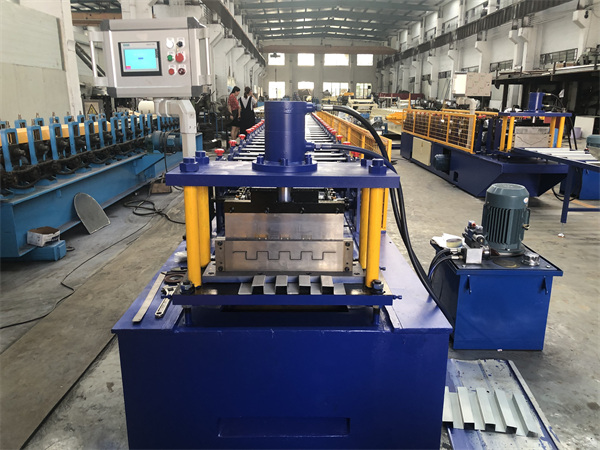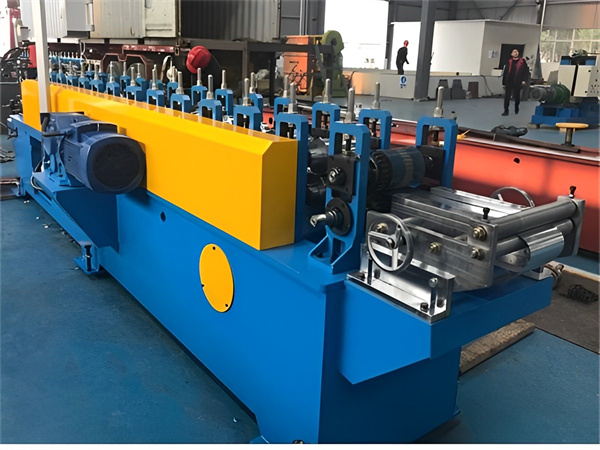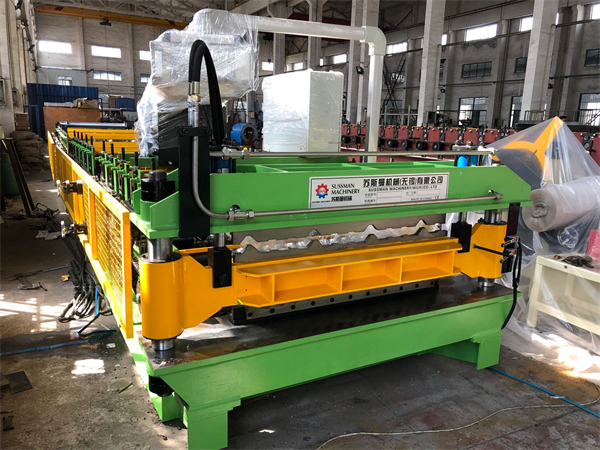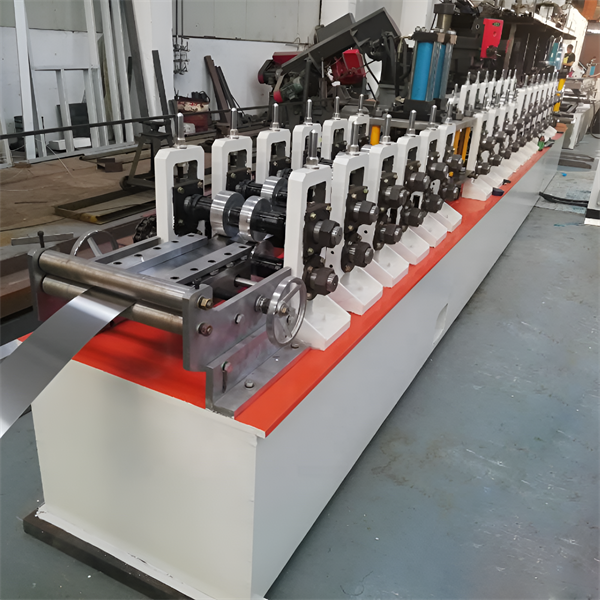Metal roof panel roll forming machines are used to produce metal roofing sheets and panels from coiled metal strips. This equipment is widely utilized to manufacture roofing components for industrial, commercial and residential buildings.
Metal roofing provides numerous benefits such as durability, fire resistance, energy efficiency, and design flexibility. The roll forming process allows efficient, continuous and high-volume production of roof panels tailored to required sizes and profiles.
This comprehensive guide provides metal roofing contractors, building product manufacturers and other buyers an overview of metal roof panel roll formers, their working, types, main components, technical specifications, and suppliers. We have compiled key information in easy-to-read tables and charts for quick reference.
Overview of Metal Roof Panel Roll Forming Equipment
Roll forming is a continuous bending operation in which sheet or coil metal stock is passed through consecutive roll stands to progressively shape it into custom profiles. Metal roof panel roll forming machines comprise a series of roll stations that transform flat metal strips into trapezoidal, corrugated or other shaped roofing product as per the roller die shapes.
Here are the key details about these machines at a glance:
| Equipment | Metal Roof Panel Roll Forming Machine |
| अनुप्रयोग | Manufacturing metal roof panels, sheets for industrial, commercial and residential roofing |
| Metal Material | Galvanized steel, aluminum, copper, stainless steel, titanium zinc sheets/coils |
| Thickness Capacity | 0.3mm to 2mm |
| Profile Types | Trapezoidal, Corrugated, Tile, Standing Seam, Custom |
| Width Capacity | 650mm to 1500mm |
| रफ़्तार | 10 – 25 meters per minute |
| प्रक्रिया | Coil feeding, de-coiling, levelling, notching, punching, roll forming, cutting, stacki |
Roll formed metal roof panels provide benefits such as:
- Durability and long service life
- Corrosion and fire resistance
- Quick and efficient installation
- Design flexibility and aesthetic appeal
- Structural strength and stability
- Thermal efficiency and energy savings
- Low maintenance
- लागत प्रभावशीलता
Modern metal roof panel production lines feature high automation, easy changeover between profiles, advanced control systems and safety mechanisms.

Types of Metal Roof Panel Roll Forming Machines
Metal roof panel roll forming equipment is available in a range of configurations, automation levels and capabilities to suit different production needs, volumes and metal profiles.
The main types of these machines include:
| Types | विवरण |
|---|---|
| Manual Lines | Basic roll formers for small scale production. Manual loading and offloading of raw coils and formed panels. Suitable for small workshops and manufacturers. |
| Semi-automatic Lines | Automated decoiling and coil feeding but manual offloading. Higher output than manual lines. Good for medium production volumes. |
| Fully Automatic Lines | Automated material handling and production from loading to unloading. For high volume continuous production. PLC and HMI systems for control. |
| CNC Roll Forming Lines | CNC controlled production for precision forming as per programmed profiles, angles and dimensions. Ideal for custom profiles. |
| Double Deck Roll Forming Lines | Two production flows parallelly double the output. One coil feeding line serves both upper and lower rolling lines. |
| Specialty Lines | Tailored lines for specialized roofing components like rain gutters, flashing, eaves, ridges etc. |
| Portable Roll Forming Machines | Compact machines for onsite small-scale forming and repairs/retrofits. |
Choosing between manual, semi-automatic and fully automatic lines depends on factors like:
- Required production volume (linear meters per day/shift)
- Frequency of profile changeovers
- Available budget and space
- Level of process automation needed
- Number of workers/operators
- Type of metal sheets – thickness, hardness, width etc.
Fully automated roll forming lines offer the highest productivity but involve higher investment costs. Manual and semi-automatic lines provide economical solutions for small roofing manufacturers and workshops.
Main Components of Metal Roof Panel Roll Forming Machines
A typical metal roof panel roll forming line comprises both forming and material handling components that work synergistically.
The major components are:
| Components | विवरण |
|---|---|
| Decoiler/Uncoiler | Feeds metal coil stock into the roll line. Includes decoiling mandrel and coil loading system. |
| Feeding/Guiding System | Controls sheet feeding speed and guides the strip alignment. |
| Shear/Cut-to-Length Device | Cuts the metal sheet to preset length before roll forming. |
| Punching Unit (optional) | Punches holes for connectivity if required. |
| Roll Forming Stands | Roller dies progressively form the metal strip into roofing profile. 10-16 stands for complex shapes. |
| Hydraulic System | Provides power for rolling pressure and components like pinch rollers. |
| Forming Controls | Automated control systems to synchronize roll stands, regulate forming parameters etc. |
| Cut-off Press | Cuts formed panels to required length as per machine setting. |
| Stacking System | Collects cut panels and stacks them systematically. |
| Conveyors | Transport metal sheets between machine components. |
| Frame and Cover | Supports components and protects from operational hazards. |
Additional secondary components like parting agents, fume exhausts, safety guarding etc. may be integrated as per application requirements. Correct configuration of components tailors the roll former for efficient profile forming.
Technical Specifications
Metal roof panel roll forming machines are available with different specifications based on the production demands. Key technical parameters are outlined below:
| Parameters | Typical Range |
|---|---|
| बनाने की गति | 10 – 25 m/min |
| Thickness Capacity | 0.3 – 2 mm |
| Width Capacity | 650 – 1500 mm |
| Product Length | Customizable up to 6000 mm |
| Power Consumption | 7.5 – 45 kW |
| रोलर स्टेशन | 10 – 16 |
| Roller Materials | 45# Steel, Stainless Steel |
| Drive System | Servo/Stepper Motor, Hydraulic |
| वोल्टेज | 220V/380V/415V 3 Phase |
| Machine Dimensions | 8000-30000 mm x 2000-4000 mm x 2000-2500 mm |
| वज़न | 8000 – 15000 kg |
- Forming speed determines output and typically ranges from 10-25 meters per minute depending on metal thickness and product complexity.
- Thickness capacity is suitable for most roofing metals from 0.3mm to 2mm thick coils.
- Width capacity up to 1500mm allows forming large metal sheets in one run.
- Configurable length as per building requirements up to 6000mm.
- 10-16 roller stations provide the progressive bending power and profiles. More roll sets allow longer panels and complex shapes.
- Roller materials like 45# steel offer durability during high-volume production.
- Servo motors offer accurate speed control. Hydraulic drive provides high forming force.
- Suitable three-phase power supply and protection for smooth functioning.
- Compact yet rigid frame structure for stability during operation.
- Weight up to 15000kg for dealing with heavy coil stock and process forces.
Applications and Suitable Metal Roof Profiles
Metal roof panel roll forming equipment allows efficient production of roofing sheets and panels in different profiles. Common applications include:
| अनुप्रयोग | विवरण |
|---|---|
| Industrial Buildings | Manufacturing units, warehouses, power plants, metro sheds |
| Commercial Buildings | Offices, malls, hotels, airports, stadiums, institutions |
| Residential Buildings | Apartments, individual homes, sheds |
| Retrofit/Re-roofing | Upgrading existing building roofing |
These machines can produce different metal roofing profiles as per die shapes:
| Roofing Profiles | विवरण |
|---|---|
| Trapezoidal | Symmetrical trapezoid cross-section. Good spanning capacity. |
| Corrugated | Sinusoidal or curved wave-like cross-section. Lightweight and strong. |
| Standing Seam | Vertical interlocking seams. Waterproof and durable. |
| Batten Seam | With visible batten caps. Aesthetic appeal. |
| Roman Tile | Resembles tile roofing. Visual attractiveness. |
| रीति | Any special shape, curve or panel design. |
Trapezoidal, corrugated and standing seam profiles are most common for industrial and commercial buildings. Batten seam, Roman tile and customized profiles provide architectural appeal for high-end residential roofing.

How to Choose Right Metal Roof Panel Roll Forming Equipment
Choosing suitable roll forming equipment for your production depends on factors like:
| Parameters | विवरण |
|---|---|
| Output Requirement | Expected daily/monthly metal roofing production quantity. |
| Metal Properties | Type, thickness, width, and grade of metal coils. |
| Roof Profile | Shape, dimensions and complexity of required panel design. |
| Level of Automation | Manual, semi-auto or fully automatic line. |
| Production Space | Available floor space for machine installation. |
| Budget | Capital investment capability. |
| Production Staff | Number and skill of workers/operators. |
| Changeover Needs | Frequency of profile changeovers required. |
| Accessories Integration | Additional punching, notching, cutting needs. |
Analyzing above parameters helps determine optimal roll former configuration – forming speed, automation level, number of roller stands etc. This ensures the machine matches your production scale, roofing profiles, operational requirements and budget.
Metal Roof Panel Roll Forming Machine Suppliers
There are many equipment manufacturers providing metal roof panel roll forming solutions. Some major international suppliers include:
| Company | Location |
|---|---|
| FLEXIE | China |
| Artcobell | China |
| Evertek | Turkey |
| UNIFORM | China |
| SDJB | China |
| Felss | Germany |
| Rollmech | भारत |
When choosing a supplier, consider factors like:
- Technical expertise and engineering capability
- Experience in delivering roofing projects
- Roll former configuration range
- Quality and durability of components
- Customization and line integration capabilities
- Automation and control systems
- Training and support services
- Pricing and delivery time
- Production throughput guarantees
- Line trial and testing provisions
- After-sales service and spare part supply
Reputable manufacturers can engineer optimized metal roof panel production lines matching your specific requirements and budget. They provide turnkey solutions from design to installation to production support.
Metal Roof Panel Roll Forming Machine Prices
Metal roof panel roll forming equipment costs depend on:
- Line automation level – manual or automatic
- Production speed and output
- Machine size and configuration
- Type of control systems
- Additional integrated components like punching, stackers etc.
- Standard or customized machine design
Here is an overview of price ranges:
| Line Type | मूल्य सीमा |
|---|---|
| Manual Roll Forming | $5000 – $15000 |
| Semi-automatic Roll Forming | $15000 – $50000 |
| Fully Automatic Roll Forming | $30000 – $100000 |
| CNC Roll Forming | $50000 – $200000 |
- Manual roll formers cost lower due to basic design and manual material handling.
- Semi-automatic machines are mid-range since some automation increases the price.
- Fully automatic lines are most expensive due to complete automation systems.
- CNC roll formers with precision programmable control command premium pricing.
- Production capacity directly influences cost. High-speed heavy-duty lines are pricier.
- Customized lines are costlier than standard machine layouts.
- Additional integrated accessories like coil cars, stacking systems further increase price.
- Large suppliers tend to be costlier than smaller regional players.
For small businesses with limited production volumes, budget manual or semi-automatic lines are recommended. Large manufacturers benefit from automated lines for high-volume continuous production.
How to Install Metal Roof Panel Roll Forming Equipment
Proper installation of roll forming machines by professional technicians ensures smooth functioning, operational safety and forming accuracy. The key steps are:
Site Preparation
- Ensure adequate space for machine footprint, safe access, material loading/unloading and movement.
- Floor should be flat, levelled, and strong enough to handle equipment load.
- Electrical supply lines should be prepared as per voltage and load requirements.
Transportation and Handling
- Use appropriate lifting and moving equipment like cranes, forklifts etc. of sufficient capacity.
- Remove machine components from packaging and inspect for damages if any.
- Place machine frame, stands, and parts safely to avoid accidents.
Positioning and Alignment
- Position and anchor the machine frame securely on the floor as per layout plans.
- Align and level roll stands symmetrically according to markers.
- Arrange forming and handling components in sequence.
Assembly and Connections
- Assemble stands, shafts, gears, motors as per instructions.
- Verify alignments, axis angles and clearances.
- Install and connect electrical, hydraulic and control circuits.
Testing and Trial Runs
- Check direction of motor rotation, hydraulic pressure etc.
- Conduct trial runs initially at slow speed looking for aberrations.
- Make adjustments to achieve smooth performance and right formed profile.
- Repeat testing until optimal forming results are consistently achieved.
Safety Measures
- Install safety guarding, barriers, emergency stops appropriately.
- Clearly mark risky and high voltage areas to prevent accidents.
- Train workers about safe operational and material handling procedures.
Proper installation by following structural, electrical, and mechanical guidelines ensures the roll former operates safely with precision for years.

How to Operate a Metal Roof Panel Roll Forming Machine
Correct operating procedures are vital for achieving right quality and output. Key steps include:
Pre-Operation Checks and Settings
- Verify electrical connections, hydraulic pressure, lubrication levels.
- Program/set machine speed, length of panels, die profiles.
- Ensure emergency stops are working.
Material Loading
- Use overhead cranes or coil cars to load coil stock onto decoiler.
- Thread sheet end through the equipment, aligning it squarely.
Running Production
- Start motors and let machine reach preset speed gradually.
- Monitor strip feeding, pre-cutting, roll forming and panel cutting.
- Inspect quality of first few panels. Make any necessary adjustments.
- Let production continue smoothly at the set pace.
Safety Practices
- Use ear protection against equipment noise.
- Ensure no exposed body parts are near rotating or moving components.
- Be attentive and stay clear of dangerous areas.
- Stop operation immediately if any unsafe situation is noticed.
Post-Operation
- Stop the line systematically and relieve hydraulic pressure.
- Clean equipment and clear any metal scrap debris.
- Lubricate moving parts to prevent rusting.
Profile Changeover
- Orderly stop production and machine. Remove existing profile roller dies.
- Carefully install dies of new desired profile shape and sequence.
- Trial run and check formed profile until accuracy is achieved.
- Adjust parameters if necessary before full production.
Proper operating discipline coupled with regular maintenance enhances productivity while minimizing disruptions, defects and hazards.
Maintenance of Metal Roof Panel Roll Forming Machines
Consistent preventive maintenance is crucial for longevity and performance of roll forming equipment. Key aspects include:
| Activity | Frequency |
|---|---|
| Inspecting roll tooling | Daily |
| Checking belt tension & alignment | Weekly |
| Lubricating roller bearings | Weekly |
| Replacing hydraulic oil filters | 6 Months |
| Checking chain/gear wear | Yearly |
| Refurbishing or replacing tooling | 2-3 Years |
| Replacing hydraulic components | 5 Years |
- Daily checks of roll dies, punch tools for wear, cracks or damage.
- Regular lubrication of bearings, gears maintains smooth motion and prevents rust.
- Timely replacement of filters and fluids maintains proper hydraulic functioning.
- Worn-out chains, gears deteriorate forming accuracy over time.
- Roll dies require refurbishing or replacement based on use intensity and observations during quality checks.
- Hydraulic pumps, valves etc. need overhaul or replacement depending on duty cycles.
Preventive maintenance as per schedules and run-time saves costly disruptions during production.
Advantages and Limitations of Metal Roof Panel Roll Forming
Benefits
- Highly efficient continuous production of panels at fast speeds
- Ability to create diverse roofing profiles for applications
- Consistent quality and dimensional accuracy of panels
- Lower per unit cost compared to alternate methods
- Minimal scrap generation due to precision forming
- Effective utilization of coiled metal raw material
- Adaptable to small or large production volumes
- High initial machinery investment cost
- Complex profile changes require die changeovers and machine downtime
- Limited capability to produce complex 3D roofing shapes
- Risk of sheet deformation if parameters not set correctly
- Loud operational noise necessitates protective gear
- Requires skilled technicians for operation and maintenance
- Not suited for very small or extremely large custom roofing
- Panel seaming or interlocking often required post-production
While roll forming is highly beneficial for bulk roof panel production, manufacturers should strategically choose when to use it over other processes like metal stamping based on production needs and capabilities.

सामान्य प्रश्न
Here are some common queries about metal roof panel roll forming machines:
| Sr. No. | Questions | Answers |
|---|---|---|
| 1 | What types of metals can be roll formed? | Galvanized steel, aluminum, copper, stainless steel, and titanium zinc coils. |
| 2 | What are the different roof profiles produced? | Trapezoidal, corrugated, batten seam, standing seam, Roman tiles, custom profiles. |
| 3 | What thickness of metal coils are suitable? | Typically 0.3mm to 2mm thickness capacity. |
| 4 | What is forming speed of these machines? | 10 to 25 meters per minute depending on metal properties. |
| 5 | What are the key machine components? | Decoiler, feeder, pre-cutter, punch, roll stations, cut-off press, stacker. |
| 6 | How to choose right roll forming equipment? | Based on output, metal type, profile design, automation level, budget. |
| 7 | What regular maintenance is required? | Lubricating, inspecting roll tooling, replacing filters, checking belt/chain wear. |
| 8 | What safety aspects are important? | Machine guarding, electrical insulation, protective gear for operators. |
| 9 | What factors determine price of roll formers? | Speed, automation level, size, controls, accessories. |
| 10 | Should roll forming be used for small or large production? | Ideal for medium to large production volumes. |
Metal roof panel roll forming machines offer efficient forming solutions to produce a high volume of roofing components once parameters are set up accurately. With proper selection, operation and maintenance, manufacturers can leverage these machines to enhance productivity and profitability.
निष्कर्ष
Metal roof panel roll forming lines allow bulk production of diverse formed profiles from metal coils in an automated continuous process. With capabilities to control shape dimensions and process parameters, these machines offer accuracy along with high output.
This guide summarizes key considerations and helpful information for manufacturers planning to invest in roll forming equipment – types of machines, main components, technical specifications, suitable applications, operational guidelines, maintenance practices and more. Comparing specifications and production needs assists in selecting optimal roll former configurations.
With increasing adoption and steady improvements in automation, metal roof panel roll forming equipment continues to gain popularity as the systems of choice for high-quality, cost-effective formed component production.
